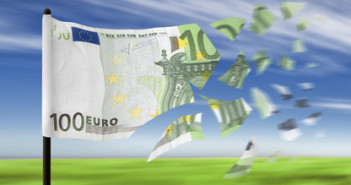EUR/USD was hit by a constant flow of disappointing GDP numbers from the old continent: France officially entered a recession, Germany barely escaped one and Italy’s economy contracted again. These numbers sent the pair to new lows. Also data from the US fell short of expectations, but euro/dollar only saw a limited bounce, far from a recovery. How low will we go?
Here is a quick update on the technical situation, indicators, and market sentiment that moves euro/dollar.
EUR/USD Technical
- Asian session: Euro/dollar failed to recover the 1.2960 line in the Asian session, and later fell to support at 1.2880, before losing this level as well and hitting a new low of 1.2842.
- Current range: 1.28 – 1.2880.
Further levels in both directions:

- Below: 1.2805, 1.2750, 1.27, 1.2624 and 1.2587.
- Above: 1.2880, 1.2960, 1.30, 1.3030, 1.31, 1.3160 and 1.32.
- 1.2805 is the border of the long term 1.2805 – 1.3170 and is critical support.
- 1.2880 turns into resistance, but it is not that strong at the moment. 1.2960 is more significant.
Euro falls on weak euro-zone GDP – click on the graph to enlarge.
EUR/USD Fundamentals
- 5:30 French GDP: exp. -0.1%, actual: -0.2%.
- 6:00 German GDP: exp. +0.3%, actual +0.1%.
- 6:45 French CPI: exp. +0.1%, actual -0.1%.
- 8:00 Italian GDP: exp. -0.4%, actual -0.5%.
- 9:00 Euro-zone GDP: exp. -0.1%, actual -0.2%.
- 12:30 US PPI: exp. -0.6%, actual -0.7%. Core PPI +0.1% as expected.
- 12:30 US Empire State Manufacturing Index: exp. +3.6, actual -1.4 points.
- 13:00 USÂ TIC Long-Term Purchases: exp. +33.8 billion, actual -13.5 billion.
- 13:15 US Industrial Production: exp. -0.1%, actual -0.5%.
- 13:15 US Capacity Utilization Rate: exp. 78.4%, actual 77.8%.
- 14:00 USÂ NAHB Housing Market Index: exp. 43 points, actual: 44 points.
For more events and lines, see the EUR/USD
EUR/USD Sentiment
- Euro-zone recession continues: The euro-zone contracted for a third quarter in a row. Output fell by 0.2%. At the time of the publication, this wasn’t totally unexpected, as Germany provided a big disappointment earlier: the economy grew by only 0.1% in Q1, short of 0.3% expected. Q4 was revised to a contraction of 0.7%. Also other countries disappointed. No end is in sight. This sent the euro lower.
- Negative deposit rates looming: The mention of negative deposit rates was not accidental. Earlier in the week, ECB member Ignazio Visco reiterated that the ECB is considering the idea. The ECB would be the first major central bank to adopt negative deposit rates. Proponents of the idea argue that it would increase lending to businesses and help boost economic activity in the sluggish Eurozone, but it could also scare money away, too fast. The mere mention of the negative rate weighs on the euro.
- US picture brighter, but not a one way street: Recent  employment numbers have been looking positive. Last week, Unemployment Claims came in at 323 thousand new claims, well below the estimate of 333 thousand. It was the third consecutive week that jobless claims has beaten expectations. This is excellent news, but the markets will want to see strong numbers from other sectors of the economy to be convinced that the US is headed in the right direction. Retail sales were good, but fresh data such as the Empire State indicator and industrial production curbed the dollar rally.
- Â To taper or not to taper: This is the question facing the Federal Reserve. Is the recovery sustainable? The Fed mentioned that fiscal policy is restraining the recovery, but at least tax revenue is up, and this defers the political issues regarding the debt ceiling.



